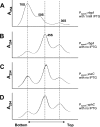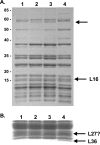Multiple GTPases participate in the assembly of the large ribosomal subunit in Bacillus subtilis
- PMID: 16997968
- PMCID: PMC1698177
- DOI: 10.1128/JB.01213-06
Multiple GTPases participate in the assembly of the large ribosomal subunit in Bacillus subtilis
Abstract
GTPases have been demonstrated to be necessary for the proper assembly of the ribosome in bacteria and eukaryotes. Here, we show that the essential GTPases YphC and YsxC are required for large ribosomal subunit biogenesis in Bacillus subtilis. Sucrose density gradient centrifugation of large ribosomal subunits isolated from YphC-depleted cells and YsxC-depleted cells indicates that they are similar to the 45S intermediate previously identified in RbgA-depleted cells. The sedimentation of the large-subunit intermediate isolated from YphC-depleted cells was identical to the intermediate found in RbgA-depleted cells, while the intermediate isolated from YsxC-depleted cells sedimented slightly slower than 45S, suggesting that it is a novel intermediate. Analysis of the protein composition of the large-subunit intermediates isolated from either YphC-depleted cells or YsxC-depleted cells indicated that L16 and L36 are missing. Purified YphC and YsxC are able to interact with the ribosome in vitro, supporting a direct role for these two proteins in the assembly of the 50S subunit. Our results indicate that, as has been demonstrated for Saccharomyces cerevisiae ribosome biogenesis, bacterial 50S ribosome assembly requires the function of multiple essential GTPases.
Figures





Similar articles
-
The essential GTPase RbgA (YlqF) is required for 50S ribosome assembly in Bacillus subtilis.Mol Microbiol. 2006 Jan;59(2):528-40. doi: 10.1111/j.1365-2958.2005.04948.x. Mol Microbiol. 2006. PMID: 16390447
-
YphC and YsxC GTPases assist the maturation of the central protuberance, GTPase associated region and functional core of the 50S ribosomal subunit.Nucleic Acids Res. 2016 Sep 30;44(17):8442-55. doi: 10.1093/nar/gkw678. Epub 2016 Aug 2. Nucleic Acids Res. 2016. PMID: 27484475 Free PMC article.
-
Interaction between Bacillus subtilis YsxC and ribosomes (or rRNAs).FEBS Lett. 2015 Apr 13;589(9):1026-32. doi: 10.1016/j.febslet.2015.03.001. Epub 2015 Mar 13. FEBS Lett. 2015. PMID: 25771857
-
Role of GTPases in bacterial ribosome assembly.Annu Rev Microbiol. 2009;63:155-76. doi: 10.1146/annurev.micro.091208.073225. Annu Rev Microbiol. 2009. PMID: 19575570 Review.
-
Critical steps in the assembly process of the bacterial 50S ribosomal subunit.Nucleic Acids Res. 2024 May 8;52(8):4111-4123. doi: 10.1093/nar/gkae199. Nucleic Acids Res. 2024. PMID: 38554105 Free PMC article. Review.
Cited by
-
Biochemical characterization of ribosome assembly GTPase RbgA in Bacillus subtilis.J Biol Chem. 2012 Mar 9;287(11):8417-23. doi: 10.1074/jbc.M111.331322. Epub 2012 Jan 20. J Biol Chem. 2012. PMID: 22267738 Free PMC article.
-
Functional characterization of EngA(MS), a P-loop GTPase of Mycobacterium smegmatis.PLoS One. 2012;7(4):e34571. doi: 10.1371/journal.pone.0034571. Epub 2012 Apr 10. PLoS One. 2012. PMID: 22506030 Free PMC article.
-
Insights into the function of the chloroplastic ribosome-associated GTPase high frequency of lysogenization X in Arabidopsis thaliana.Plant Direct. 2024 Jan 11;8(1):e559. doi: 10.1002/pld3.559. eCollection 2024 Jan. Plant Direct. 2024. PMID: 38222931 Free PMC article.
-
RbgA ensures the correct timing in the maturation of the 50S subunits functional sites.Nucleic Acids Res. 2022 Oct 28;50(19):10801-10816. doi: 10.1093/nar/gkac059. Nucleic Acids Res. 2022. PMID: 35141754 Free PMC article.
-
The universally conserved prokaryotic GTPases.Microbiol Mol Biol Rev. 2011 Sep;75(3):507-42, second and third pages of table of contents. doi: 10.1128/MMBR.00009-11. Microbiol Mol Biol Rev. 2011. PMID: 21885683 Free PMC article. Review.
References
-
- Arigoni, F., F. Talabot, M. Peitsch, M. D. Edgerton, E. Meldrum, E. Allet, R. Fish, T. Jamotte, M. L. Curchod, and H. Loferer. 1998. A genome-based approach for the identification of essential bacterial genes. Nat. Biotechnol. 16:851-856. - PubMed
-
- Ban, N., P. Nissen, J. Hansen, P. B. Moore, and T. A. Steitz. 2000. The complete atomic structure of the large ribosomal subunit at 2.4 A resolution. Science 289:905-920. - PubMed
-
- Bashan, A., I. Agmon, R. Zarivach, F. Schluenzen, J. Harms, R. Berisio, H. Bartels, F. Franceschi, T. Auerbach, H. A. Hansen, E. Kossoy, M. Kessler, and A. Yonath. 2003. Structural basis of the ribosomal machinery for peptide bond formation, translocation, and nascent chain progression. Mol. Cell 11:91-102. - PubMed
-
- Britton, R. A., B. S. Powell, S. Dasgupta, Q. Sun, W. Margolin, J. R. Lupski, and D. L. Court. 1998. Cell cycle arrest in Era GTPase mutants: a potential growth rate-regulated checkpoint in Escherichia coli. Mol. Microbiol. 27:739-750. - PubMed
Publication types
MeSH terms
Substances
LinkOut - more resources
Full Text Sources
Molecular Biology Databases

